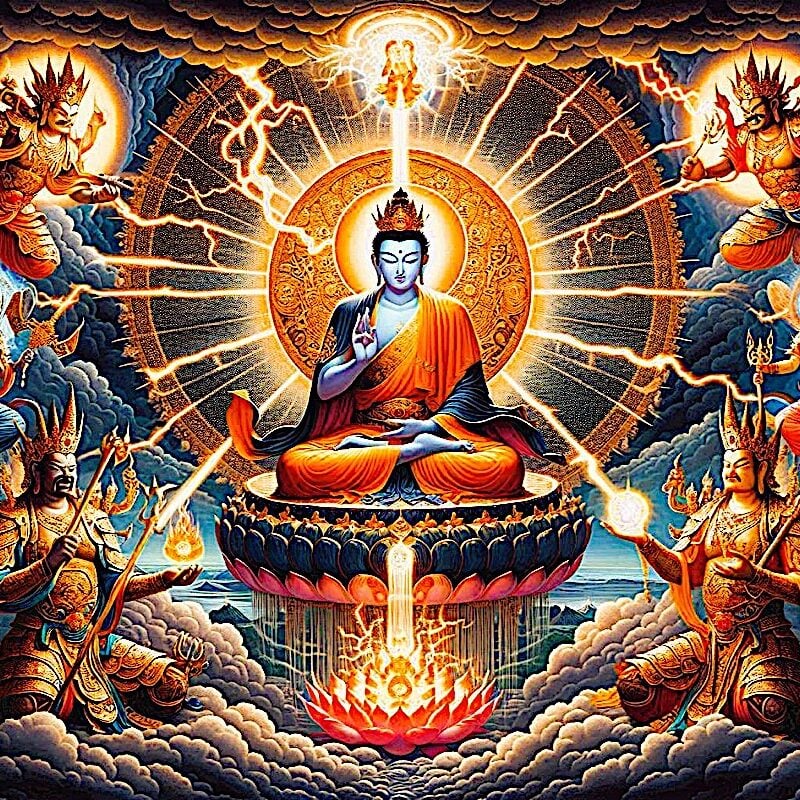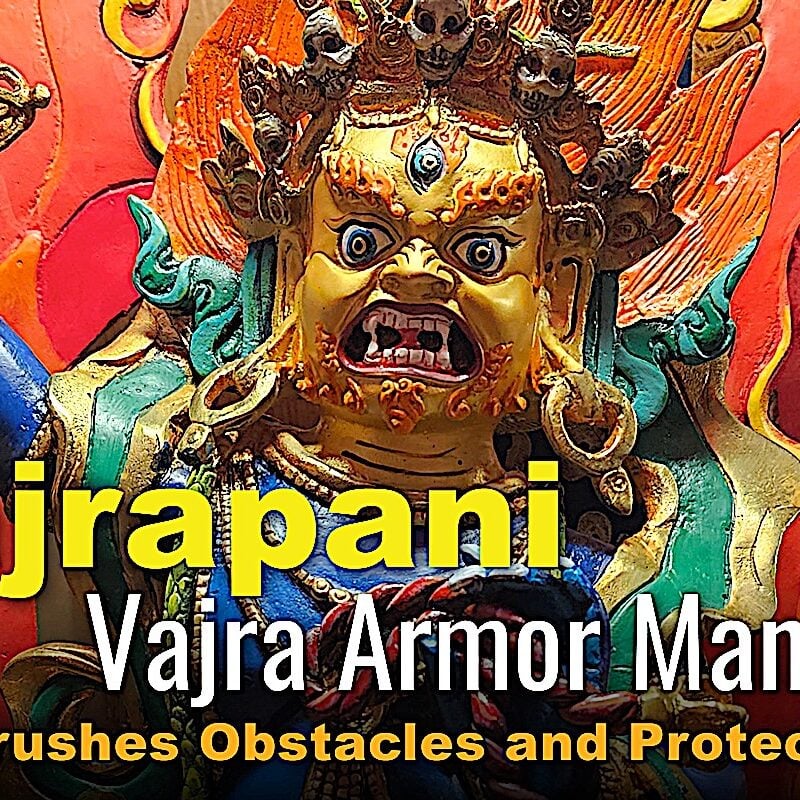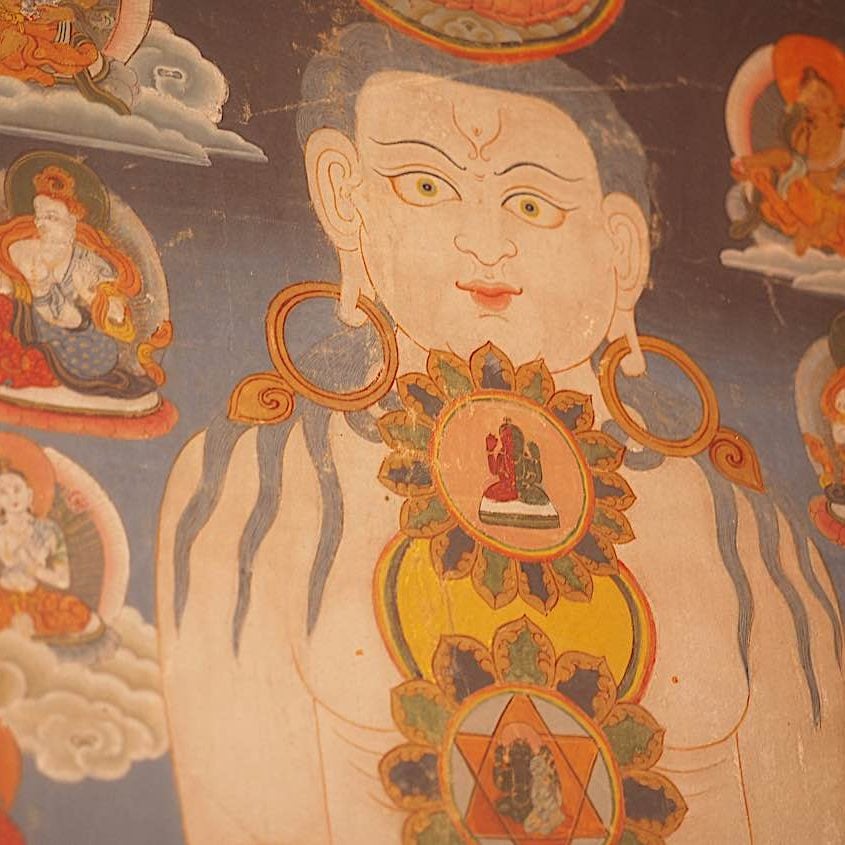Vajrasattva Video: Guided Visualization and Long Mantras (non musical) With Helpful Introductory Documentary
Don’t miss this beautiful visualized short guided journey into the mandala of Vajrasattva, with the long mantra and purification visualization, beautifully illustrated with the amazing art of Thomas Edwards and Laura Santi.
The on-screen visualization is guided by our editor Lee Kane, and introduced with a concise but helpful ‘documentary’ introduction. (Time coded Chapters below if you’d like to skip forward to the visualizations or mantras.
- Fully subtitled in 48 languages! (Transcript in English below.)
Why do many Buddhists consider purification practice to be the ultimate meditative practice? Why do Tibetan Buddhists consider Buddha Vajrasattva practice to be the most perfect and complete of purification practices? Do I need special instruction to practice this most profound purification and healing practice? We answer these questions and more in this presentation. Then, take a visualized meditative journey of body, speech and mind with our editor Lee Kane as he describes a simple purification visualization and ends with 108 repetitions of the profound 100-syllable mantra of Vajrasattva.
CONTENTS
00:00 Introduction
01:00 The Goal in Buddhism of Purification of the Five Aggregates
01:11 Shakyamuni Buddha battles Mara under the Bodhi Tree (animation)
02:31 Buddha’s example of purification
02:49 Methods of purification including Vajrasattva Practice, the ultimate purification
03:28 Sound Psychological Concept of Buddhist Purification
05:13 The 100-syllable mantra introduction
05:53 Vajrasattva is a complete practice in itself
06:32 Why is it so powerful?
07:19 How do we know it works?
08:27 How to pronounce mantra in Sanskrit 3 times (non-musical) (see mantra below)
10:21 Detailed meaning/translation of mantra from Lati Rinpoche
13:03 “Mechanics of Vajrasattva Practice” a How-to
14:03 The Four Opponent Powers: Dependence, Regret, Remedy, and Restraint
15:13 VISUALIZATION BEGINS (Painting by Thomas Edwards art and animations)
19:53 Seven non-musical repetitions of Vajrasattva 100-Syllable Mantra
MANTRA in Sanskrit (pronunciation guide at 08:27)
OM VAJRASATTVA SAMAYA MANUPALAYA
VAJRASATTVA TVENOPATISHTHA
DRIDHO ME BHAVA
SUTOSHYO ME BHAVA
SUPOSHYO ME BHAVA
ANURAKTO ME BHAVA
SARVA SIDDHIM ME PRAYACCHA
SARVA KARMA SU CHAME
CHITTAM SHRIYAM KURU HUM
HA HA HA HA HO
BHAGAVAN SARVA TATHAGATA
VAJRA MA ME MUNCHA
VAJRA BHAVA MAHA SAMAYA SATTVA
AH HUM PHAT!
ART CREDITS
Thomas Edwards on Facebook>>
Laura Santi Sacred Art on Etsy>>
Or her website>>
Transcript
Vajrasattva, the Great Purifier, powerful and profound Buddhist Healing and Purification
Why do many Buddhists consider purification practice to be the ultimate meditative practice? Why do Tibetan Buddhists consider Buddha Vajrasattva practice to be the most perfect and complete of purification practices? Do I need special instruction to practice this most profound purification and healing practice? We answer these questions and more in this presentation. Then, take a visualized meditative journey of body, speech and mind with our editor Lee Kane as he describes a simple purification visualization and ends with 108 repetitions of the profound 100-syllable mantra of Vajrasattva.
All Buddhist practices could ultimately be described by the goal “purification of the five aggregates” — through various forms of meditation and virtues. Purification is a core concept.
The Example of Shakyamuni Buddha
When Shakyamuni Buddha sat under the Bodhi tree, seeking Enlightenment, the sutras record the many things he visualized as he sat. Imagine that epic battle under the tree. Outwardly, we see only the Buddha, serene and still. Inwardly, the Buddha faced all the maras.
Clouds of arrows and spears whistle through the air, arcing up in a terrible cloud, now descending to pierce the Buddha. Yet Buddha sits, unmoving, his concentration so perfect that he sees only the true nature of mind. The arrows become lotus flowers, fluttering harmlessly to the ground. Next, he is surrounded by monsters and demons, with flashing teeth and roaring voices as terrible as nature’s worst tempest. Then, he is confronted with alluring, seductive women — Mara’s own daughters sent to seduce them.
Buddha reaches forward, and touches the ground. With the earth as his witness, he is shielded from Mara’s defilements and temptations. His perfect shield from all these terrors is loving kindness, compassion, and wisdom.
This was the iconic attack of Mara, the tempter.
You can see these beasts as literal demons, or, in more phycological terms, as defilements to be purified.
This purification of defilements, as demonstrated by Buddha’s fearless, unmoving battle under the Bodhi tree, is a core practice in Buddhism.
In Buddhist thinking, we all face Mara’s temptations — as obscurations, impurities and negative obstacles in our daily practices. Like, Buddha, we can overcome them. We can purify the impurities through various profound methods, from mindfulness meditation to advanced visualization, such as Vajrasattva meditation, visualization and mantras — methods that involve all three of body, speech and mind.
Foundation practice in Buddhism is generally thought of as the process of purifying obstacles and misconceptions and negative karmas, and generating merit.
Vajrasattva meditation and mantra is the best-known of the purification practices in Tibetan Buddhism — practices that psychologist Robert Preece in his book, The Psychology of Buddhist Tantra, demonstrated are based on sound psychological concepts:
“The primary obscuration to be purified is dualistic thinking and its consequences… Increasingly, our health, both physical and psychological, is affected by the environments in which we live and work. The intensity of emotional stress from work will invariably leave a residue within our nervous systems… Healing and purification visualizations are usually of light and blissful nectar washing through the body… this gradually cleanses, heals or purifies…”
Why do we visualize Buddha as Vajrasattva, glowing with purifying light, for this practice? In Vajrayana practice, we understand Buddha or Buddhas can appear in any form suited to either the purpose of our meditation, or ideal for our state of mind.
Vajrasattva, like all Buddhist deities, defies the notion of ego. Therefore, there is no “who” and there is no “what.” It can be said that Vajrasattva is none other than ourselves, visualized as a pure Buddha. It can be said that Vajrasattva is an emanation of Akshobya — or of Vajradhara, or of Samantabhadra. It can be said that Vajrasattva, in ultimate reality is no different from any other Buddha. But, it can be said, in relative reality, that Vajrasattva is a caring and loving deity. All of these are true at the same time and none of them really define Vajrasattva.
Here, for purification, we visualize the Buddha in the form of a pure being of white light.
The 100 Syllable Mantra
Vajrasattva’s 100-syllable mantra is a complete and empowering practice in itself. When combined with visualization, it is considered the most profound purification practice possible — so much so, that regardless of a person’s chosen meditational deity, the meditation always starts and finishes with a Vajrasattva visualation and mantra meditation to purify obstacles and obstructions. If we are practicing Chenrezig, Tara, Hayagriva, Vajrayogini or any deity, we start and end with Vajrasattva practice. It is foundational to most practices in Vajrayana.
Vajrasattva is also a complete practice in itself. No other yidam is needed. Purification is healing — so Vajrasattva is a healing practice. Purification is wisdom — so Vajrasattva is a wisdom practice. Removing our obstacles and purifying our defilements is also important to Compassion practices.
Vajrasattva is also accessible to all. Although it is beneficial to have empowerment and training from a teacher, none is required. His mantra, and visualization, when combined with intention and regret, is certainly effective for anyone.
Why is the practice so powerful?
As Buddha taught, our five aggregates — form, sensation, perceptions, mental formations and consciousness — are the very things that become obscured and create our obstacles to Enlightenment. Obstacles and incorrect perceptions of the true nature of reality prevent us from wisdom — and ultimately — Enlightenment. For this reason, it could be argued that purification in all its forms is the main and most important Buddhist practice. This can take many forms: mindful meditation, insight meditation, visualized and deity meditations and mantra.
How do we know it works?
We know we can rely on the Vajrasattva practice because of a lineage of masters who have used the practice for hundreds of years — many of whom achieved great insights on the path. But what makes it so profoundly effective?
Vajasattva incorporates meditation of mind, body, and speech. Our mind is engaged by visualization of the beautiful deity Vajrasattva — the perfected ideal of an Enlightened being. If we practice deeper, we visualize Vajrasattva with his consort, the Wisdom mother. We visualize purifying light from Vajrasattva entering the crown of our heads and filling us. We engage body with mudra, posture (sitting position) and breath. We engage speech with the sacred Sanskrit 100-syllable mantra of Vajrasattva:
OM VAJRASATTVA SAMAYA MANUPALAYA
VAJRASATTVA TVENOPATISHTHA
DRIDHO ME BHAVA
SUTOSHYO ME BHAVA
SUPOSHYO ME BHAVA
ANURAKTO ME BHAVA
SARVA SIDDHIM ME PRAYACCHA
SARVA KARMA SU CHAME
CHITTAM SHRIYAM KURU HUM
HA HA HA HA HO
BHAGAVAN SARVA TATHAGATA
VAJRA MA ME MUNCHA
VAJRA BHAVA MAHA SAMAYA SATTVA
AH HUM PEY!
It can be helpful to understand the meaning of the Sanskrit phrases — although it is by no means necessary.
Mantra Explanation
The great teacher Lati Rinpoche explained the meaning this way:
OM is the start syllable of most mantras. This syllable is actually an amalgam of A-U-M syllables in Sanskrti, which represent of the vajra body, speech and mind.
VAJRA in the Buddha’s Name represents the indivisible nature and inseparability of wisdom and bliss.
SATTVA in the Buddha’s name indicates this Enlightened being has the wisdom of inseparable bliss and emptiness.
SAMAYA MANU PALAYA means ” protect my commitment.”
VAJRASATTVA TVENO PATISHTA = O Vajrasattva, may I achieve you, may I become closer to you
DRIDHO ME BHAVA = may this achievement be stabilized (remain firmly with me)
SUTOSHYO ME BHAVA = may your nature become pleased (may you be pleased with me)
SUPOSHYO ME BHAVA = may you make me into the nature of passion (may you be happy with me)
ANURAKTO ME BHAVA = may you make me the victor (have affection for me)
SARVA SIDDHI ME PRAYACCHA = grant me all the powerful attainments
SARVA KARMA SUCHAME = grant me all the activities (make all my actions good)
CITTTAM SHRIYAM KURU = may your glory abide within my heart (make my mind most glorious)
HUM = (represents primordial awareness)
HA HA HA HA HO = I shall delight in the powerful attainments and in all the activities (the five types of
wisdom)
BHAGAVAN SARVA TATHAGATA = calling out to all the Buddhas by name
MAME MUNCHA = do not part from me (do not abandon me)
VAJRA BHAVA = make me the one who can hold a vajra
MAHA SAMAYA SATTVA = call to Vajrasattva by saying, “O One with the great commitment.” The
significance of calling out like this is to say, “Just as I have requested, may this request be granted.”
AH = syllable of the vajra speech (shows the empty nature of all phenomena. The main function of
Buddhas’ speech is to teach that phenomena lack inherent existence.)
HUM = (blissful state of Vajrasattva’s wisdom)
PHAT or PEY! = destroy all the delusions and sufferings.
The mechanics of the practice
With most Buddhist meditations there is a reason for every method. This practice is profoundly effective by virtue of its complex simplicity. The complexity of memorizing a 100-syllable mantra, then reciting it with full concentration while visualizing not only a perfect Buddha but also the mantra script and purifying light — all the while keeping our body relaxed and mindful, with perfect breathing. Yet, once mastered, it is one of the simpler practices. Complex, yet simple.
Many teachers tell their students Vajrasattva practice is all they need. After all, most lay Buddhists work day jobs and have family lives, so undertaking Vajrasattva practice is already a major — yet important — undertaking. But the main reason a teacher might say “Vajrasattva is all you need” is because it can be considered a complete and profound practice.
Beyond the perfection of a practice involving all three of Body, Speech and Mind, Varjasattva practice also includes the profound “Four Opponent Powers”:
- The Power of Dependence: Taking Refuge in the Three Jewels, Buddha, Dharma and Sangha.
- The Power of Regret: recalling all of our negative actions in the past motivated by ignorance, attachment or aversion.
- The Power of Remedy: the mantra and visualization and mental focus on purification.
- The Power of Restraint: or undertaking to refrain from creating negative karma (actions) in future.
When we practice Vajrasattva, as we visualize and chant mantras, we meditate on the four opponent powers. We meditate on the importance of our refuge in the Three Jewels — our true protection. We consider all the things we regret, and we focus on (visualize) our regrets being purifying by the wondrous nectar or white light of Vajrasattva. We then make a promise to ourselves to refrain from negative karmas again — because we know this opportunity to practice Dharma in this human life is so precious.
Vajrasattva Purification Visualization
Come along with me now, as I visualize, Vajrasattva. Here, we’ll visualize Vajrasattva by himself, although in Vajrayana practice, we always know, in our minds, that all Buddhas combine both compassion and wisdom — which is often visualized as the Father/Mother Buddha. For simplicity, this visualization is Vajrasattva as a glowing white deity of light.
You can visualize Vajrasattva in front of you, with light coming from his compassionate heart into your body, purifying you. Or, more traditionally, we visualize Vajrasattva on top of our head, with light coming down into the crown of our head, and filling our body with purifying light. This might be more difficult for some to visualize. It’s best to do whatever is easiest for you.
All Buddha’s, in all visualizations, arise out of the emptiness that is everything or Oneness.
Half close your eyes, as you journey in your mind, perhaps sitting in a room with a single stick of non-irritating incense — or visualize the incense. You remain conscious of your own body, the body full of defilements that you are about to purify. Perhaps you see that body as dark and grey and smokey, and filled with obtsructions that appear as sludge or slime or any way you visualize negativities. Don’t worry about being literal. These are visual symbols of your obstacles.
Remain mindful and watchful. Now, you glimpse a white light, a glowing light which appears to take the form of a syllable PAM. This PAM, these beautiful glowing letters, transform into a stunningly beautiful white lotus with a thousand petals! So beautiful. So amazing. Just floating in front of you or over head. You can’t take your half closed eyes off the spectacal of white, sacred light — blissful energy, tangible and real. You can feel that purifying energy pulsing with power. It vibrates. Your hair almost stands on end. You feel the energy all around you now.
Now, on that thousand-petaled lotus you see a HUM syllable, white and pure and glowing with the light of a thousand suns! So brilliant. So wondrous! The light is going out in all directions, touching all sentient beings everywhere, from insects to animals, to humans to spirits — everyone is touched and purified. Now, you see that hum is transforming into a vajra — a beautiful glowing white vajra. And in a flash of brilliant light, this transforms into Vajrasattva, white and pure and HOLY and beautiful. He looks like a perfect being. In your mind, because you are human, he appears as a youthful, perfect human, but he is made of light, of the energy and magnificence of bliss and emptiness, of wisdom and compassion. He has one beautiful face and two elegant arms, and he holds a sacred bell in his left hand resting on his lap, and a vajra in his right hand at his heart.
Everything is pure white. You can see definition, a white body, a white face, white hair, white vajra — but it’s is all levels of luminous, beautiful light.
And, you find yourself spontaneously confessing all of your negativities. You find yourself regretting them. You promise yourself you will not repeat them in future. You continue chanting the remedy, the mantra, together with the beautiful visualization as you are purifed and take full refuge in the Three Jewels.
Chant the mantra along with me, the 100 syllables — of just listen as you visualize for now — that white light is pouring into your body. It enters the crown of your head, and fills your body.
All of the dark smoke and sludge and negativities are dissolved instantly in the blazing light of purification.
In the back of your mind, you remember the opponent powers of regret. You regret your broken word, your damaged pledges. And, you think you hear the voice of Vajrasattva, his Holy voice, speaking in your mind, saying,
“Oh child of good family, your negativities and obscruations and damaged and broken pledges are cleansed and purified.”
And you commit in your mind, not to allow to return to the unwholesome activities that caused your defilements. You regret and you promise yourself you will restrain yourself in future. To do this, you will take refuge in the Three Jewels: Buddha, Dharma and Sangha.
And now you see yourself with a similar white, pure, glowing body, similar to Vajrasattva — pure and purified. And, you continue to chant the sacred mantra:
OM VAJRASATTVA SAMAYA MANUPALAYA
VAJRASATTVA TVENOPATISHTHA
DRIDHO ME BHAVA
SUTOSHYO ME BHAVA
SUPOSHYO ME BHAVA
ANURAKTO ME BHAVA
SARVA SIDDHIM ME PRAYACCHA
SARVA KARMA SU CHAME
CHITTAM SHRIYAM KURU HUM
HA HA HA HA HO
BHAGAVAN SARVA TATHAGATA
VAJRA MA ME MUNCHA
VAJRA BHAVA MAHA SAMAYA SATTVA
AH HUM PEY!
2 thoughts on “Vajrasattva Video: Guided Visualization and Long Mantras (non musical) With Helpful Introductory Documentary”
Leave a Comment
More articles by this author

Windhorse Tara Practice: Tara, the Wind of Life; Tara, Goddess of Wind, Buddha of Activity, Karma Mother

Protection from all Harm, Natural Disaster, Weather, Spirits, Evil, Ghosts, Demons, Obstacles: Golden Light Sutra: Chapter 14

SUPPORTING MEMBER VIDEO: Tara Windhorse – Buddhist Wish-Fulfilling Practice: the Mother of all Mantras, Chi, Wind and Prana

Guru Rinpoche is ready to answer and grant wishes: “Repeat this prayer continuously” for the granting of wishes
Search
Latest Features
Please support the "Spread the Dharma" mission as one of our heroic Dharma Supporting Members, or with a one-time donation.
Please Help Support the “Spread the Dharma” Mission!

Be a part of the noble mission as a supporting member or a patron, or a volunteer contributor of content.
The power of Dharma to help sentient beings, in part, lies in ensuring access to Buddha’s precious Dharma — the mission of Buddha Weekly. We can’t do it without you!
A non-profit association since 2007, Buddha Weekly published many feature articles, videos, and, podcasts. Please consider supporting the mission to preserve and “Spread the Dharma." Your support as either a patron or a supporting member helps defray the high costs of producing quality Dharma content. Thank you! Learn more here, or become one of our super karma heroes on Patreon.
Lee Kane
Author | Buddha Weekly
Lee Kane is the editor of Buddha Weekly, since 2007. His main focuses as a writer are mindfulness techniques, meditation, Dharma and Sutra commentaries, Buddhist practices, international perspectives and traditions, Vajrayana, Mahayana, Zen. He also covers various events.
Lee also contributes as a writer to various other online magazines and blogs.















Thank you for the information. I wanted to ask: do we need to sit for this practice? Can we do it while walking or doing chores?
Traditionally we sit (or stand or walking — in my case, for instance, with arthritis, I prefer standing meditation) — but generally not while doing chores — if only because it can be risky to take your mind off the chores. Even something simple like walking up the stairs — there’s a safety issue if you focus your mind exclusively on practice while moving about. If you’re referring, though, to mantra chanting and related visualizations during daily life, that certainly can be done anytime, anywhere — and that’s encouraged — as long as it doesn’t distract from what you are doing (i.e. like driving). In Tibetan Buddhism, the concept of “daily yoga” is that we try to stay in the state of meditation (to varying degrees) even while doing mundane things. For instance, we eat a meal, and visualize we are offering that food to the Vajrasattva at our heart (Vajrasattva is normally visualized at our heart inseperable from us — the heart is the seat of the mind). We visualize all people we meet as Enlightened beings, and their speech as Enlightened speech, and so on — but that’ difficult for most of us. So, chanting mantras whenever we can is helpful, even while doing chores. (With the disclaimer on attention and safety, of course!) Even when you do engage in ‘daily life yoga’ like this, it’s still beneficial to do a slightly more formal session in the morning or night to allow our mind and body and speech (i.e. mantras) to rest in the natural state.